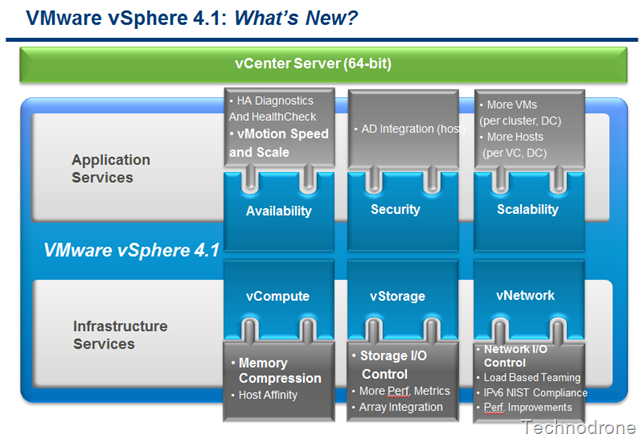What's New in vSphere 4.1
A small group of people were granted access to the Release Candidate Beta and over the past 3 weeks have been exposed to the new features and improvements that are involved with this new release. I was one of this group.
There are going to be an abundance of posts flying fast over the next few days, with a huge amount of information.One of the purposes of the program, was to spread the word and expose the new features that are available with the new release.
So here goes.
First some marketing material. Several technical posts with more details will follow over the next few days.
Leveraging more than a decade of industry-leading technology, VMware vSphere™ sets a new standard as the most robust and reliable virtualization platform, and now forms the best foundation
for building cloud infrastructures. VMware vSphere is used in over 170,000 deployments in companies of all sizes throughout the world. The latest release of VMware vSphere (version 4.1) pushes the platform even further by:
- Dramatically expanding the scale of the platform to an unmatched number of virtual machines and virtualized hosts, enabling the creation of private and public clouds at even lower operational costs than before.
- Introducing new capabilities for the most efficient aggregation of IT resources into an elastic pool of computing power that applications can consume on demand as a utility-like service.
The major new and enhanced features that vSphere 4.1 delivers are listed below and grouped by the major benefits of the platform:
Efficiency through utilization and automation
Agility with control
Freedom of choice
The sections below outline each of these benefits in greater detail.
Efficiency through Utilization and Automation
vSphere 4.1 enables higher consolidation ratios with unequaled performance by providing groundbreaking new memory management technology, expanded resource pooling capabilities with more granular storage and network I/O controls, and major enhancements to overall scalability.
vCompute
- Memory Compression—Reclaim application performance by up to 30 percent by reducing memory contention as a bottleneck
- DRS Host Affinity—Set granular policies for virtual machine movement (for example, restricting a virtual machine to a specific host due to licensing impact)
vStorage
- Storage I/O Control—Set storage quality-of-service priorities for each virtual machine to guarantee access to storage resources
- Performance Reporting—Deliver key storage performance statistics regardless of storage protocol
- Array Integration—Leverage new protocol interfaces between VMware and storage arrays for faster performance for vSphere operations such as Storage vMotion events and virtual machine provisioning.
vNetwork
- Network I/O Control—Set network quality-of-service priorities per flow type for guaranteed access to network resources.
Scalability
“Cloud Scale”*—Fully virtualize the datacenter and scale at least twice as large than ever before
- Virtual machines per cluster: 3,000 (more than a 200 percent increase)
- Hosts per vCenter Server instance: 1,000 (more than a 300 percent increase)
- Virtual machines per vCenter Server instance: 10,000 powered on (more than a 300 percent increase), 15,000 registered
*All scale numbers above show the new 4.1 metric, as well as the increase from the vSphere 4.0 release (4.0 numbers are above in the same pillar).
Agility with Control
vSphere 4.1 extends its award-winning availability and security capabilities with the world’s fastest live migrations and the ability to respond in parallel to any business need or change. Application services enhancements deliver new status details for high availability and tighter integration with an existing directory service.
Availability
- VMware vMotion™—Speed and scale enhancements to vMotion deliver superior platform response and availability by migrating virtual machines up to five times faster and enabling up to eight vMotion events in parallel.
- VMware High Availability—Deeper diagnostic and health check capabilities further enhances application availability in virtual machines Security
Security
- Active Directory integration—Seamless user authentication at the vSphere host (rather than at the vCenter Server level) for centralized user management. Easily assign privileges to users or groups plus roll out permission rules across hosts.
Scale
- Create private and public clouds twice as large as before with the ability to run more than twice as many virtual machines in a cluster, manage more than three times as many hosts, and manage more than three times as many powered-on virtual machines from a single vCenter Server console.
Freedom of Choice
- vSphere 4.1 builds on the VMware ecosystem, not only in terms of increased hardware and software support, but also by opening new possibilities for tie-in with cloud computing.
Open and Interoperable Architecture
- APIs—vSphere 4.1 enables partners to leverage new storage APIs for array integration thus enhancing performance and availability. The vSphere platform can also be leveraged through the new vCloud API for an open and interoperable computing model in the cloud.
Expanded Support
- HCL—vSphere 4.1 offers an expanded hardware compatibility list (HCL) that supports more operating systems, devices, applications, and service providers than any other virtualization platform; vSphere 4.1 also includes new support for third-party serial port concentrators (for enhanced management) and the latest x86 processors.
For a complete and detailed list of new features and capabilities in VMware vSphere 4.1, visit https://www.vmware.com/go/vsphere

